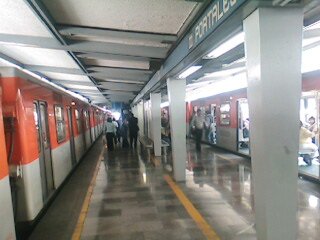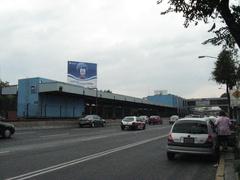
Portales Mexico City: Visiting Hours, Tickets, and Historical Sites Guide
Date: 14/06/2025
Introduction to Portales Mexico City
Situated in the Benito Juárez borough, Portales is a dynamic Mexico City neighborhood renowned for its rich colonial legacy, vibrant markets, and eclectic architecture. Evolving from the 19th-century Hacienda de Nuestra Señora de la Soledad de los Portales, this area now captivates visitors with its harmonious blend of history, culture, and contemporary urban life. Whether you are a history enthusiast or a traveler seeking authentic local experiences, Portales promises a multifaceted adventure (wikicity.com; maspormas.com).
Explore early 20th-century homes alongside modernist icons like the Sagrada Familia Church and the Templo de la Medalla Milagrosa. Enjoy the bustle of Mercado Portales, immerse yourself in local festivals, and discover cultural hubs such as Parque de los Venados. With excellent metro and bus connections, Portales is accessible and full of surprises. This guide offers comprehensive advice—covering history, travel tips, ticketing information, and must-see attractions—so you can make the most of your visit. For a tailored experience, use the Audiala app for self-guided tours and event updates (maspormas.com; mexicocity.cdmx.gob.mx).
Table of Contents
- Introduction
- Colonial Origins and Early Development
- Urbanization in the 20th Century
- Architectural and Urban Character
- Economic and Social Life
- Cultural Significance and Community Identity
- Visiting Portales: Practical Information
- Visiting the Sagrada Familia Church
- Discovering Templo de la Medalla Milagrosa
- Monumento a la Revolución
- Frequently Asked Questions
- Conclusion
Colonial Origins and Early Development
Portales traces its roots to the colonial-era Hacienda de Nuestra Señora de la Soledad de los Portales, which was owned by General Manuel Sánchez de Tagle—a prominent figure in Mexico’s independence—until 1847 (wikicity.com). In 1888, Francisco Cravioto Gallardo and Herbert P. Lewis purchased the land, subdividing it in 1916 to pave the way for urban development (maspormas.com).
Urbanization in the 20th Century
The 1920s marked a period of rapid urbanization for Portales and its neighbors, Del Valle and Santa Cruz. By 1928, Portales became the administrative hub of the General Anaya delegation, and later integrated into the Benito Juárez and Coyoacán boroughs in 1944 (wikicity.com). The inauguration of Metro Line 2, with Portales station as a key stop, further connected the neighborhood to greater Mexico City (maspormas.com).
Architectural and Urban Character
Portales is celebrated for its diverse architecture: from early 20th-century residences to mid-century modernist buildings and contemporary homes. Its streets feature cosmopolitan names, referencing global locales and notable Mexican sites (maspormas.com). The Sagrada Familia Church, designed by Enrique Carral Icaza (1960–1967), stands out for its vibrant stained glass and imposing bell tower (mexicocity.cdmx.gob.mx).
Economic and Social Life
Primarily residential, Portales supports a robust local economy with family-run shops, traditional bakeries, hardware stores, and pharmacies. Mercado Portales is a highlight, attracting visitors citywide to its tianguis for antiques and used furniture (mexicocity.cdmx.gob.mx). Educational institutions and a variety of essential services contribute to the neighborhood’s self-sufficiency (wikicity.com).
Cultural Significance and Community Identity
Portales has fostered esteemed cultural icons such as Óscar Chávez, Fernando Bustos, and Carlos Monsiváis, known as “El mago de la Portales” (maspormas.com). The area’s cultural heartbeat is Parque de los Venados, which hosts performances at Teatro de los Hermanos Soler and educational programming at Planetario Joaquín Gallo. The park’s historic fair has long drawn visitors, reinforcing Portales’ reputation as a cultural hub (wikicity.com).
Visiting Portales: Practical Information
- Getting There: Take Metro Line 2 (Portales and Ermita stations), Metro Line 12 (Parque de los Venados), or city buses.
- Visiting Hours: Mercado Portales opens daily from early morning to late afternoon. Churches and cultural centers follow regular service and event schedules.
- Tickets and Costs: Public spaces are free to enter. Some events or performances may require tickets—check listings in advance.
- Accessibility: Most metro stations and main streets are accessible, though older buildings may have limitations.
- Nearby Attractions: Explore Centro Nacional de las Artes, Santa Cruz Atoyac, San Simón Ticumac, and Calzada de Tlalpan.
- Guided Tours/Photography: Local guides offer walking tours focusing on Portales’ history and architecture. The markets, street scenes, and Sagrada Familia Church make excellent photo subjects.
Visiting the Sagrada Familia Church
Introduction
Set in Portales Oriente, the Sagrada Familia Church is a modernist landmark and a spiritual anchor for the community. Its bold design and dynamic parish life make it an essential stop for visitors.
Visiting Hours and Admission
- Hours: Daily, 7:00 AM–8:00 PM
- Admission: Free; donations are appreciated. The church functions as an active place of worship.
Tours and Special Events
- Guided Tours: Not held regularly, but local cultural centers like Casa de Cultura Gaby Brimmer sometimes offer group visits and workshops.
- Special Events: Major Catholic holidays feature notable ceremonies and processions, open to the public.
Accessibility
The church has ramps at main entrances and accessible restrooms. Metro (Portales station, Line 2) and buses provide easy access. Ridesharing apps like Uber and Didi are also convenient.
Photographic Spots
Capture the church’s modernist façade and stained glass, as well as local life in the adjacent plazas. For the best light, visit in the early morning or late afternoon. Remember to be discreet during services and avoid flash photography inside.
Nearby Attractions
- Casa de Cultura Gaby Brimmer: Offers cultural workshops and programs (mexicocity.cdmx.gob.mx).
- Mercado Portales: Known for antiques and local products.
- Parque de los Venados: Ideal for relaxation and people-watching.
Visitor Tips
- Dress modestly for religious services.
- Check cultural center schedules for special events.
- Prefer public transport or ridesharing for hassle-free travel.
- Observe local customs and photography guidelines.
Discovering Templo de la Medalla Milagrosa
About the Temple
Built in the 1950s, the Templo de la Medalla Milagrosa is a serene religious site showcasing mid-century modernist architecture. Its distinctive façade and stained glass create a tranquil retreat in the heart of Portales (cdmxtravel.com).
Visiting Hours and Admission
- Hours: Daily, 7:00 AM–8:00 PM
- Admission: Free; donations are welcome.
- Tours: No official tours, but local guides are available nearby.
Accessibility
The temple is wheelchair accessible, with ramps and designated seating. The surrounding sidewalks are well maintained for easy access.
Events and Religious Services
Regular services include Sunday Mass at 10:00 AM, with special ceremonies during major holidays. The temple collaborates with Casa de Cultura Jaime Sabines for cultural events.
Nearby Attractions and Culinary Experiences
- Parque de los Venados: A spacious park for relaxation.
- Mercado Portales: Enjoy Mexican street food and crafts.
- Casa de Cultura Jaime Sabines: Art exhibitions and performances.
- Tianguis de Antigüedades Portales: A weekend flea market.
- Food: Savor tacos al pastor and tlacoyos at the market, try pulque at Pulquería La Antigua Roma, or enjoy pan dulce from local bakeries.
Getting There
Accessible via Metro Line 2 (Portales station) and various bus routes. Walking and biking are convenient within the neighborhood; taxis and rideshares are widely available.
Visual and Multimedia Resources
Preview the temple and its surroundings via the official tourism page, which features images and maps.
Monumento a la Revolución: History, Visitor Information, and Tips
History and Significance
The Monumento a la Revolución, located in Plaza de la República, is a monumental tribute to the Mexican Revolution and houses the tombs of revolutionary leaders. Originally intended as a legislative palace, it was completed in the 1930s as an Art Deco masterpiece (Mexico City Tourism).
Visiting Hours and Tickets
- Hours: Daily, 9:00 AM–6:00 PM
- Tickets: ~MXN 70 (US$3.50); discounts for children, seniors, and Mexico City residents.
- Purchase: At the entrance or online through Mexico City Tourism.
Transportation
- Metro: Revolución station (Line 2).
- Metrobus: Stops on Avenida de los Insurgentes.
- Biking: ECOBICI stations nearby.
- Rideshare/Taxis: Uber and Didi are safe and convenient.
Accessibility
The monument features elevators and ramps; the observation deck is wheelchair accessible.
Guided Tours and Events
Guided tours are available in Spanish and English. Plaza de la República hosts numerous events, especially around November 20.
Nearby Attractions
- Plaza de la República: Public square with markets and festivals.
- Museo Nacional de San Carlos: European art collections.
- Colonia Portales: Explore further for markets and dining.
Photography and Visitor Tips
- Best light during early morning or late afternoon.
- The observation deck offers panoramic city views.
- Visit weekdays or off-peak hours for a quieter experience.
- The area is generally safe; standard precautions are advised.
Frequently Asked Questions (FAQ)
Q: Is there an entrance fee to Portales’ public spaces?
A: No, entry to the neighborhood, markets, and churches is free.
Q: What are the best times to visit Mercado Portales?
A: Visit in the morning for a lively atmosphere and fresh selections.
Q: Are there guided tours in Portales?
A: Yes, local guides offer tours focused on history, architecture, and markets.
Q: Is Portales accessible by public transport?
A: Yes, via Metro Lines 2 and 12 and several bus routes.
Q: Are Portales attractions family-friendly?
A: Yes, especially Parque de los Venados and local cultural centers.
Q: Is photography allowed in churches and monuments?
A: Yes, but avoid flash and be respectful during services.
Conclusion
Portales exemplifies Mexico City’s rich tapestry of history, culture, and community spirit. From its colonial beginnings to its energetic present, the neighborhood invites visitors to explore architectural landmarks, savor authentic cuisine, and engage with local traditions. Whether you are browsing Mercado Portales, attending Mass, or strolling through Parque de los Venados, Portales offers a memorable and meaningful journey.
Enhance your visit by using resources like guided tours, cultural events, and the Audiala app for a personalized experience. Stay informed via official tourism websites and social media channels for the latest updates and insider tips.
References and Further Reading
- Exploring Portales: History, Culture, and Visiting Tips for Mexico City’s Historic Neighborhood, 2024, MASPORMAS (maspormas.com)
- Colonia Portales Norte, 2024, WikiCity (wikicity.com)
- Sagrada Familia Church in Portales, 2024, Mexico City Government (mexicocity.cdmx.gob.mx)
- Templo de la Medalla Milagrosa, 2024, CDMX Travel (cdmxtravel.com)
- Mercado Portales, 2024, Mexico City Government (mexicocity.cdmx.gob.mx)
- Mexico City Metro System
- Mexico Travel Secrets: Safety and Transport Tips
- Mercado Portales - Time Out Mexico
- Casa de Cultura Jaime Sabines - CDMX Official
- Mexico City Historical Sites - PlanetWare
- Mexico City Food Tours - Will Fly For Food
- Official Monumento a la Revolución Website
- Mexico City Tourism Board











































































































































































